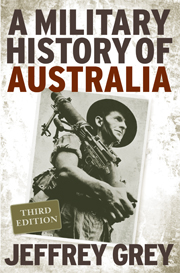Book contents
- Frontmatter
- Contents
- Maps, Tables, Figures and Measurement
- Acknowledgements
- Introduction to the Third Edition
- Introduction to the Second Edition
- 1 The British Period, 1788–1870
- 2 The Military and the Frontier, 1788–1901
- 3 The Colonial Period, 1870–1901
- 4 A New Nation and Its Military Forces, 1901–1914
- 5 The Great War, 1914–1918
- 6 The Inter-war Years, 1919–1939
- 7 The Second World War, 1939–1941
- 8 The Second World War, 1942–1945
- 9 The Postwar Challenge, 1945–1955
- 10 The Wars of Diplomacy, 1955–1972
- 11 From Cold War to Global War on Terror, 1972–
- Appendix 1 Chronological List of Chiefs of Staff of the Armed Forces
- Appendix 2 The Armed Forces: Strength and Expenditure
- Select and Annotated Bibliography
- Index
6 - The Inter-war Years, 1919–1939
Published online by Cambridge University Press: 22 September 2009
- Frontmatter
- Contents
- Maps, Tables, Figures and Measurement
- Acknowledgements
- Introduction to the Third Edition
- Introduction to the Second Edition
- 1 The British Period, 1788–1870
- 2 The Military and the Frontier, 1788–1901
- 3 The Colonial Period, 1870–1901
- 4 A New Nation and Its Military Forces, 1901–1914
- 5 The Great War, 1914–1918
- 6 The Inter-war Years, 1919–1939
- 7 The Second World War, 1939–1941
- 8 The Second World War, 1942–1945
- 9 The Postwar Challenge, 1945–1955
- 10 The Wars of Diplomacy, 1955–1972
- 11 From Cold War to Global War on Terror, 1972–
- Appendix 1 Chronological List of Chiefs of Staff of the Armed Forces
- Appendix 2 The Armed Forces: Strength and Expenditure
- Select and Annotated Bibliography
- Index
Summary
The years between the two world wars were a depressing period in the history of Australian military and defence policy. As is so often the case, the triumphant end of a major war led to a widespread running-down of the machinery of national defence, while an understandable revulsion from war brought about by the casualty lists of the Western Front meant that governments saw few votes in defence issues. As before the Great War, Australia did not act independently on defence and foreign policy issues in the 1920s and 1930s and remained firmly within the alliance system of imperial defence. The benefits which this might have brought were squandered by a generation of conservative politicians who used the theory of imperial defence as an excuse for doing little or nothing to maintain and develop Australia's own forces, aided and abetted by a Labor Party which professed a belief in collective security through the League of Nations but which opposed any measures which might create military forces capable of implementing it. Neither side was unique in its delusions: the same sorry story of inter-war failure was repeated in most of the Western democracies.
The cost of participation in the war was to be measured not only in terms of Hughes' 60 000 dead. Defence expenditure by the Commonwealth jumped from just £4,752,000 in the financial year 1913–14 to a wartime high of £104,861,000 in 1918–19, £100,044,000 of which comprised war expenditure.
- Type
- Chapter
- Information
- A Military History of Australia , pp. 123 - 143Publisher: Cambridge University PressPrint publication year: 2008



